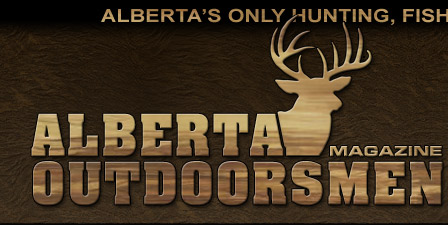Belly crawling up a small knoll and with 10 metres to go, I would soon know if my stalking of the antelope, bedded down on a sidehill just over the knoll, had been successful or not.
I had been driving north across the prairie along Tide Lake Road northeast of Brooks when I spotted a single pronghorn antelope approximately 100 metres to the left of the road where he was still bedded down in the early morning light. With the moon still visible in the morning sky and the sun just above the horizon, having just risen 15 minutes earlier at 5:40 a.m., I knew that if I pulled over this antelope would be out of his bed and gone over the hill that he was bedded down on. I noticed there was a small knoll just ahead that would allow me to pull over and stop just out of sight of the antelope.
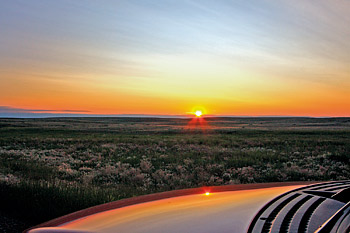 |
| “ ... I am always amazed at people who say the prairies are boring.”
|
Antelope have phenomenal eyesight and living in this open, windy, semi-arid part of southern Alberta, pronghorns depend mainly on their acute eyesight to warn them of danger, but there is nothing wrong with their hearing or sense of smell and if I was not careful, I was not going to get close to this pronghorn. Fortunately the wind was in my favour, with a light breeze blowing out of the west, putting me downwind from him. The other thing in my favour was the fact that I would be stalking the antelope with the sun at my back.
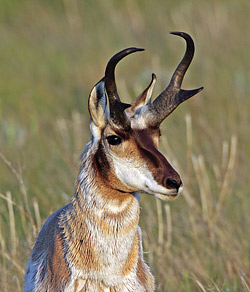 |
Pronghorn antelope are probably the most dazzling of North American animals with their distinct brown and white colouration accented by black cheek patches and glossy black horns. The pronghorn is unique to the world and North America, and is the only species that sheds its outer horn sheaths each fall. The pronghorn is not an antelope but a member of the goat family because of its lack of dew claws on the front feet. A pronghorn can attain speeds of 100 kph and cruise at 50 kph for long distances.
Growing up in southern Saskatchewan I was taught how to hunt antelope by my dad who was an avid antelope hunter. I hunted antelope for several years before trading my rifle in for a camera. I had been planning on coming out this way to the Brooks area from Calgary for some time to see if I could shoot some photos of these magnificent creatures. I have a particular need for antelope photos in the not too distant future, and I was hoping to add antelope photos to my computer hard drive.
A group of friends had been planning on a camping trip in the Brooks area and I realized this would be the perfect opportunity for me to look for antelope out on the prairies east of Brooks. Not being particularly familiar as to where I should concentrate my search, I sent an email off to an acquaintance that lives in Brooks and that I know from the ‘Talk About Wildlife’ website that I contribute to from time to time (thanks Prairiesky).
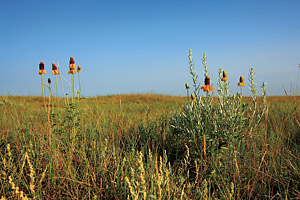 |
I had left camp at 5:00 a.m. and with a hint of dawn on the eastern horizon, I drove east on Highway 1 while keeping an eye on the screen of my Garmin navigator so I wouldn’t miss the turn off for Tide Lake Road. I was hardly out of sight of Highway 1 when I spotted three female antelope some distance off the road; although I was only mildly interested as I was on the hunt for an antelope buck.
The morning light was stunning with dawn breaking on the horizon and sunrise not too far off. I drove along at a steady 50 kph making several stops along the way to glass for signs of antelope. It amazes me that on every new adventure I find myself on how I get so much pleasure and enjoyment capturing new photos. And I am always amazed at people who say the prairies are boring. All I can tell you is that they must have their eyes closed and if you were with me on this morning, you would have agreed.
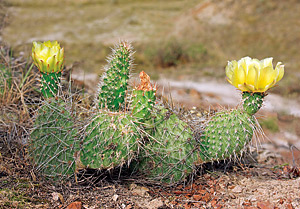 |
Having pulled my truck over out of sight of the buck antelope, I grabbed my camera with my long lens in place and set it up on a gimbel mount that was attached to a groundpod. I crossed the road and proceeded to work my way back down along the small rise in the prairie that allowed me to make my approach without being seen. Of course I was hoping the entire time that he had not vamoosed for a different part of the surrounding prairie while I was stalking him. I finally reached a point that I had mentally marked from my truck as to where I should make my final approach. I was within 20 metres of where I felt I would have him in sight, and from this point I was on my belly and crawling forward up a small knoll while pushing my camera along in front of me on my groundpod. I finally reached the point where I had to cautiously raise my head for a peek. I let out a sigh of relief to find that the antelope was still bedded down on the sidehill about 50 metres away from my position. I carefully opened up a shooting lane through the grass in front of my camera and shot my first photo and then checked the histogram to make sure of the exposure settings that I had chosen. With a minor correction I made numerous captures while the antelope looked on. I suspected that he knew something was up, although with the sun in his face he could not be sure as to what it was that he sensed. I had made a dozen captures before he stood up and after stretching, he began to move away while grazing on forbs. At this point I stood up and the hairs on his rump went erect and with a white flash, he increased his gait across the plains of his prairie home of southern Alberta.
As I made my way back to my truck and with the time not yet 6:30 a.m., I considered the day already a success and more prairie delights were yet ahead. ■
For previous Reader Stories click here.
|

